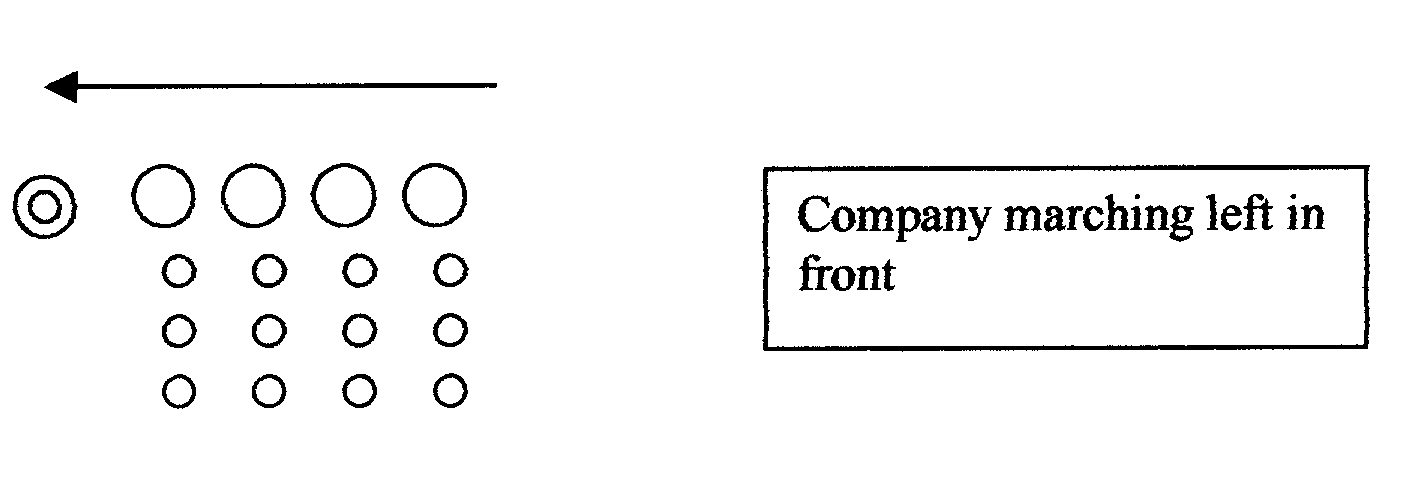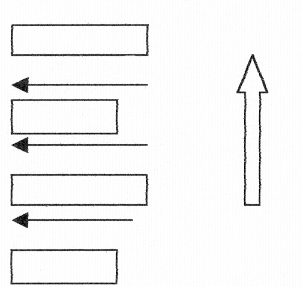
May Maneuver of the Month:
Marching straight forward
So you think marching forward is simple… It's not rocket science, that's sure; yet I see it done wrong, apparently due to simple misconceptions. There is a right way to march forward, and I'd appreciate your casting your glance over these notes.
Stepping off:
What annoys me most is failure to step off together on the left foot. The left foot part is not hard for most of us.
But in large formations in column of fours, I see a lot of failure to step off together. When we hear the word of command "march", we should all step off together. It is WRONG to wait to think about moving until the man, or company, in front of you has moved, just as it is wrong and farby to wear a red hat with a large plume. When every man delays like that, there is a long, visible, un-military, and unnecessary pause before the back of the column moves.
If we are doubled into a column of fours there is space to take a step before you can possibly collide with the man in front of you. Then if he has not moved, you can mark time. In column of twos, "without doubling" there is no such space, and there is an excuse if you are bashful about treading on the heels of the man in front of you. That's why Hardee's does not provide for facing "without doubling", which seems to me to be a reenactorism.
This problem points to inadequate understanding of, and inadequate training on, this most basic aspect of marching. That training need not be hard or long. I'm not talking about a three day course in stepping off.
Halting:
Hardee says that when the command "Halt" is given, you halt immediately. You do not adjust your distance from the next rank or company unless you are ordered to dress. You do not keep on for a few steps until your interval looks right. This principle is based on the expectation that the company guides are NCOs who know what they are doing and keep good intervals. If you weren't keeping the correct interval, then you're temporarily stuck with it. Hardee's explanation for why you should NOT make adjustments on your own is essentially that the chain reaction of adjustments can result in the dreaded accordion effect, which seriously annoys the company at the back of the column. I'd like to add that the incorrect adjustment of intervals front-to-back is often reversed when the unit "fronts" and people find out that they are being squeezed out of the line - "Give left!" "Give right!". If the basic problem is that the leading company in column straggles out to twice its proper length, then the battalion needs to correct that company.
Guiding:
We march not as individuals but as a unit. The unit guides regulate the movement of the formation, and everyone else in ranks dresses on them. That’s how we stay in those neat lines. The first and second sergeants are the unit guides in marching; right and left guides respectively.
In column of fours, the front rank man of each four dresses behind the company guide. The other men in each four dress on that front rank man. The company commander only has to regulate the movement of the guide, and the whole company marches behind the guide. This is NOT like the modern drill, in which the dress is always to the right. I say again, this is not the modern 20th / 21st century drill. Here are the two examples:
Right in front:
The guide is the First Sergeant. When the company faces right and doubles, all the front rank ones are in file behind him, like beads on a string. The first corporal will be the left (guide) man in the first four. The three other members of each four are to the right of those front rank ones, and guide on them keeping directly to the right of each one, not getting ahead of or behind him. So, you see, the dress is to the left and the rear rank two in the first four should never be creeping ahead of the First Sergeant.

Left in front:
The guide is the Second Sergeant. When the company faces left and doubles, all the front rank twos are in file behind him, like beads on a string. The three other members of each four are to the left of the front rank two, and guide on the "two". In this case (marching left in front) the dress is to the right (dress on the sergeant). The first Sergeant marches in the rank of file closers, while the company commander marches next to the Second Sergeant. When the company "fronts", the front rank will return to the line defined by the "twos" and the Second Sergeant, and the first Sergeant moves up to the front rank.

In line of battle, the front rank stays between the right and left corporals, who move with the guide. Which guide (left or right) depends on exactly what the company is doing.

When the company is in line of battle alone on the drill field, and the guide is not announced, we guide right (that is, on the First Sergeant who is the right guide).
In Battalion battle line, we guide toward the colors, which are in the center of the battalion. The companies on the right of the colors guide left. The companies on the left of the colors guide right. The color sergeant is effectively the battalion guide, only when the battalion is in line. But remember that when the colonel commands "forward" the color party marches six steps in front of the battalion, and the companies do not move until they hear "march", so the color sergeant is the guide for direction only. Remember, dress to the colors!

Thin arrows above show the direction of dress. Thick arrow shows the battalion's direction of facing/ of march.
When the battalion moves in column of companies in line, the guide is left. The second Sergeant of the second company dresses behind the Second Sergeant of the first company.
All the soldiers dress on the second sergeants. In this way, if the companies wheel left into line, the front rank of the battalion will be on the line defined by the Second Sergeants.
Because the dress is left, if the companies are not equal in size, the First Sergeants will not be behind one another.

Above, the thin arrows show the direction of dress, and the thick arrow shows the direction of movement of the battalion column of companies in line.
Cadence and length of step;
Hardee defines three cadences each of which has its own length of step, plus "the run":
1. Common time: Common time is 90 steps per minute, length 28 inches. This covers 70 yards a minute.
Common time is to be used only for recruit training "Common time will be employed only in the first and second parts of the School of the Soldier." (and, customarily, for funerals). Common time WAS the fighting cadence once upon a time, in the 18th century and before, which is why Rev War or English Civil War reenactors look like they are marching in slow motion. But by the time of the American Civil War, trained troops were expected to be able to move faster and still keep their formation.
2. Quick time: This is the ordinary maneuvering pace of Civil War armies. Quick time is 110 steps a minute, each 28 inches long. Quick time covers 85.55 yards a minute. So it is a little slower and shorter than the modern U.S. military marching step (120 x 30") which covers 100 yards a minute.
3. Double quick time: This is not a run, but is a jog. It is ordinarily 165 steps a minute, each 33 inches long. This covers 151 yards a minute. It can be sped up to 180 per minute, "At this rate a distance of four thousand yards would be passed over in about twenty-five minutes." (Hardee, 114) Units double timing do keep their dress and cover, so double timing is not a command to straggle, and we should make every effort to keep our formation. Hardee tells drill instructors to practice the soldiers in wheeling and changing direction at the double time. [Hardee, 323] Well trained skirmishers in the presence of the enemy should take intervals, assemble, and rally at the double; but we may not be so well trained. Charges are done at the double.
4. The run: This is not in cadence or in formation; and as a general rule reenactors include too many of us desk jockeys to go on runs.
[Hardee, 408] He will also exercise them in long marches at a run, the pieces carried at will; the men will be instructed to keep as united as possible, without however exacting much regularity, which is impracticable.
[Hardee, 409] The run, in actual service, will only be resorted to when it may be highly important to reach a given point with great promptitude.
Route step.
Route step means that we do not keep step (march in cadence), but break cadence. We continue to keep formation as well as we can. Route step is used to cross wooden bridges, for fear of shaking them down; for long marches, when cadence is fatiguing; and on rough ground where each man must pick his own way irregularly and the main problem is not to fall down with your loaded musket. "Route step, march" is commonly, but not necessarily, combined with "arms at will". To resume marching in step, the command is "To the step, march."
Marching to the drum:
When we march to the drum, the left foot should touch the ground on the "heavy" or "down" beat. On smooth ground it is easier to keep cadence with the drum than to march in step by any other method. Most people naturally fall in step with music, as the Greeks discovered millennia ago. For this reason it is important that the drum provide such a regular beat, with "heavy" and "light" tones every 2nd or 4th beat. The drums should not force a change - step. No jazz rhythms, please. The drums stop beating when route step is commanded.